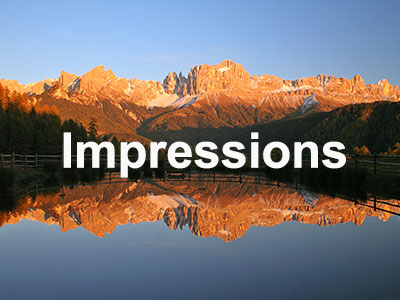Sights
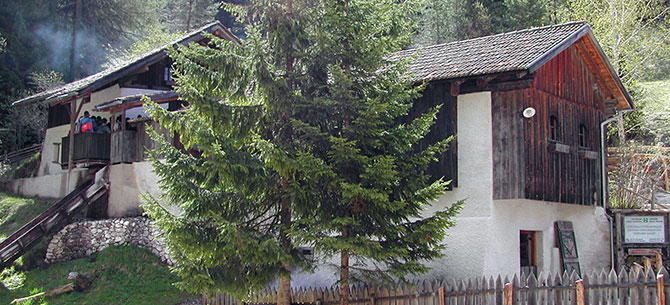
The Sciliar- Catinaccio Nature Park House
The Schlern-Rosengarten Nature Park House was opened in the locality Weißlahnbad at the entrance of the valley Tierser Tschamintal, 5 minutes from our Hotel.This information point is situated in the building of the old sawmill "Steger Säge", a rare example of a Venetian water powered sawmill. The building was renovated some years ago and the sawmill is able to function again.
Opening times:
from the beginning of june to the beginning of october
Tuesdays to Saturdays from 9.30 a.m. to 12.30 p.m. and from 2.30 p.m. to 6.00 p.m.
Open on Sundays during the months of July and August.
resentation of the Venetian sawmill:
on the opening days of the Nature Park House every Wednesday at 11 a.m., 3 p.m. and 4.30 p.m.
Guided tours for groups and schools:
From the middle of May to the end of October only upon prior appointment
Tel. +39 0471 642 196 (summer)
Tel. +39 0471 417 770 (winter).
Free entry!
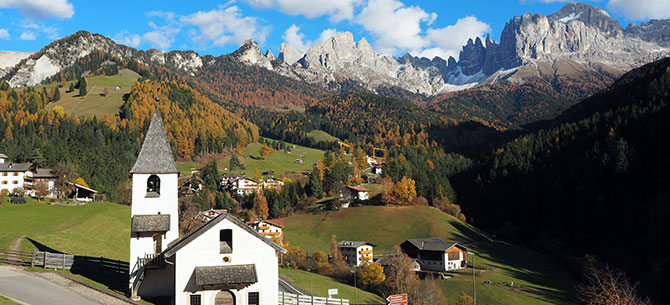
Churches in Tiers and surroundings
S. Georges Chapel Place: Tiers
From the old church from 1332 only the lower part of the tower with its Roman round arch window still remain. The red tower with its imperial roof was built in 1739. The last redesign of the church’s interior during the second half of the 19th century gave the church its New-Roman touch. The artist Karl Hernrici painted an impressive ceiling fresco in 1772.
S. Ciprian Chapel
Place: St. Zyprian, Tiers
This is a late Romanesque chapel with barrel vault, circular apse and a short bell-tower. The wall paintings on the outer wall dating back to the 17th century show the miraculous rescue of Platzlinder meadow: God threw his lightning bolts from the clouds and Saints Cyprian and Justin open their coats in order to protect the meadow and the grazing sheep. This painting is based on a legend handed down orally, which confirms that the original main settlement of Tires is not where it stands today, but in S. Cipriano.
S. Sebastian Church
Place: Tiers
The St. Sebastian Chapel with its bell-tower dates back to the plague period in 1635. Due to the solemn promise of the community it was built in Gothic style and dedicated to the Saints of the plague S. Sebastian and Rochus. The chapel was built on a spot, which was believed to be a place of pagan cult.
S. Catherine Chapel in Aica di Fiè
Place: St. Kahrein/Völser Aicha
The church was first mentioned in 1293. Only the walls of the nave and the lower part of the tower have been preserved. The star vault was built around 1500, and the triumphal arch was added. A highlight is the wall painting on the southern outer wall showing scenes from the legend of Saint Catherine.
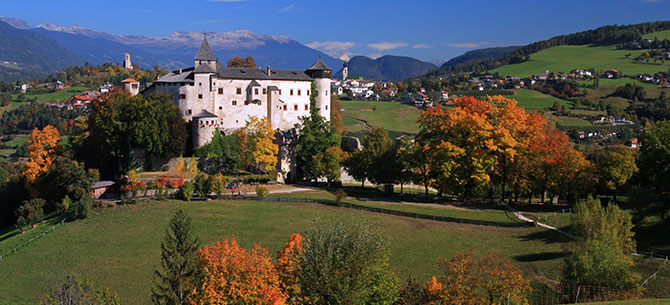
Castel Prösels
The current castle, with its gate towers, rondelle and its overall defence system, exhibits the characteristics of Kaiser Maximilian's time. During the summer, baroque and chamber music performances are held regularly in the castle.
First written documents date back to the year 1279, mentioning a so-called “castrum presile”. In 1500 Leonhard von Völs rennovated the fascinating building, adding some renaissance-style features. Those visiting the castle should cast a glance at the famous collection of arms and numerous other items such as paintings or furniture mainly originating in the 19th century. The castle, moreover, is a popular venue for all kinds of events, raning from concerts and guided visits to theatres performances, exhibitions and much more. It even hosts parts of the annual Oswald von Wolkenstein Ride, which definitely forms every year’s highlight!
Opening hours:
The castle opens its doors on a daily basis, except Saturdays; guided visits only! Further information at: +39 0471 601062
May 5 - May 31: 11 am, 2 pm, 3 pm
June 1 - June 30: 11 am, 2 pm, 3 pm, 4 pm
July 1- August 31: 10 am, 11 am, 3 pm, 4 pm, 5 pm
September 1 - September 30: 11 am, 2 pm, 3 pm, 4 pm
October 1 - October 31: 11 am, 2 pm, 3 pm
From October 31 there will only be guided visits for groups with at least 15 people (please call to ask).

Water mill
At the entrance to the village there is an old water mill. The refurbished and fully functional water mill with a large millstone can also be visited inside. In past centuries there have been several watermills, saw mills and smithies along the river powered by water. Miller, blacksmith and saw miller have been very important occupations in the Tiers valley in the past.
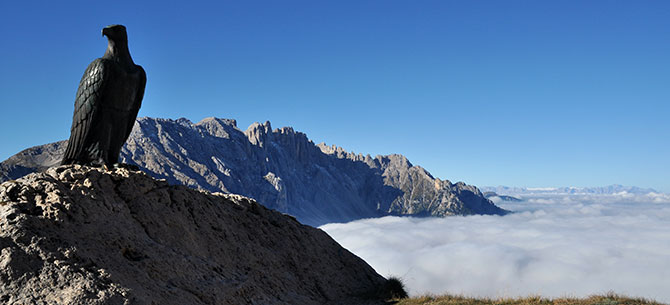
Christomannos Memorial
This three metre high bronze eagle was built in memorial of Dr. Theodor Christomannos, a dedicated mountaineer and pioneer who played an important role in the touristic development of this area. The memorial can be seen from Paolina lift in the direction of Rotwand Hut.
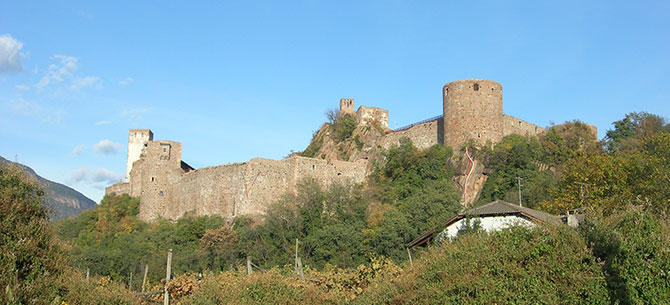
Messner Mountain Museum
The Messner Mountain Museum is located at Castle Sigmundskron (south of Bolzano), Firmian. The MMM Firmian presents information about the mountains and its people. It is intended as a meeting place for climbers from all over the world. At Sigmundskron visitors are guided on a tour explaining the history of the mountains of pictures, sculptures, photos, symbolic objects and mementos collected on numerous expeditions. The hike around the the holy mountain is called Kora in Tibet, and Reinhold Messner has eneavoured to create a Kora in his museum in Sigmundskron Castle. The crumbling chapel on the summit of the castle hill is juast as taboo as the peak of Mt. Kailash in Tibet. The MMM is neither intended as a mountaineering museum nor a museum featuring South Tyrol's mountains. It is intended to show the effect a mountain has on people. The "Enchanted Mountain" is the name Reinhold Messner has given to Sigmundskron Castle, the centrepiece of his mountain museums alias Messner Mountain Museum Firmian. The white tower consisting of several floors is the only part of the castle complex which has not planned. It is dedicated to the history of South Tyrol. Two theatre stages and a festival lawn are intended for events, while three restaurants provide visitors with refreshments after completing the museum tour.
Info
Messner Mountain Museum Firmian
Via Castel Firmiano 53 - 39100 Bolzano
Tel. +39 0471 631264 - Fax +39 0471 633884
Opening hours
From the first Sunday of March to the last Sunday of November, 10am - 6pm, last admission at 5pm
Closed on Mondays
Various evening programmes and special events
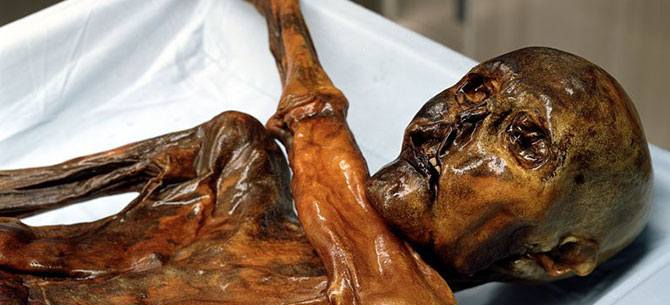
South Tyrolean Archaeological Museum
The South Tyrol's Museum of Archaeology in Bolzano/Bozen, South Tyrol, documents the Prehistory and Ancient History of South Tyrol, from the Palaeolithic and Mesolithic Age (15,000 BC) to the Carolingian times (around 800 AD). Within the overall historical framework, the Iceman ("Ötzi"), and his accompanying artefacts occupy a central position in the exhibition area. In addition to a section on the Iceman, the South Tyrolean Archaeological Museum, with an area of 1,200 square meters, presents outstanding finds from the Stone Age, the Bronze Age, the Iron Age, Roman times, and the time of Charlemagne.
Opening hours
Open Tuesday to Sunday from 10am to 6pm
Closed Mondays
Open on public holidays (not the 1st January, 1st May, 25th December)
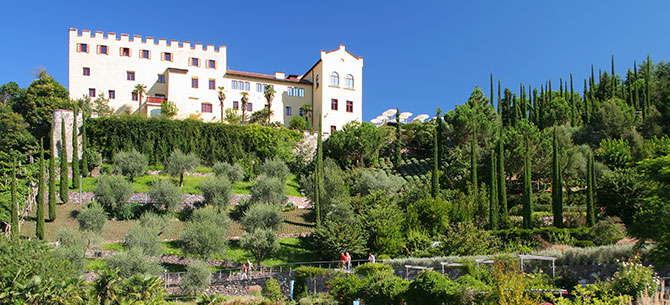
The gardens of Trauttmansdorff Castle
The Botanical Gardens of Trauttmansdorff Castle host a myriad of plants from all over the world as well as more traditional, South Tyrol scenes. Well-laid out paths wind their way from one setting to the next - from water gardens to hanging gardens, from perfumed gardens to a typical Japanese-style setting, from an area dedicated to cactus to Mediterranean groves planted with olive trees and grape vines.
The gardens, which cover a 12 hectar sight towards the east of the town, rank as the top visitors´ attraction not only in Merano itself but in South Tyrol as a whole. With over 80 different landscaped areas to choose from, the exotic, Mediterranean-style gardens are a truly unique experience. They extend over a natural amphitheatre surrounded by terraces up to 100 metres in height and give splendid, unforgettable views of Merano, the surrounding countryside and the nearby mighty mountain peaks.
Trauttmansdorff Castle and the Museum of Tourism
Trauttmansdorff Castle, a stately home with over 700 years of history, stands just above the Botanical Gardens of the same name. It was one of the favourite residence of Empress Elisabeth of Austria and her family when they came to Merano for spa treatments and has, since 2003, housed South Tyrol’s Regional Museum of Tourism. The renovated castle opened to visitors in 2008 and now houses a permanent exhibition dedicated to the Empress and her many visits to Trauttmansdorff. The view over the gardens changes according to the season, with springtime tulips followed by magnificent rhododendrons, peonies and perfumed roses. Summer days are filled with the scent of lavender, lotus flower and water lilies while autumn sees the gardens bathed in the special warmth of seasonal colours.
Events – romantic evenings accompanied by World Music events or breakfast with Sissi, exotic flower-inspired cocktails and ... much more!
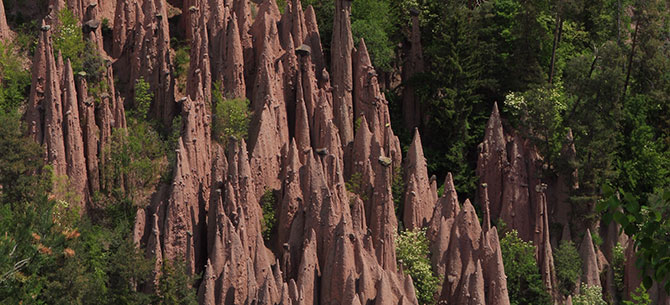
Earth Pyramids
The earth pyramids of South Tyrol have taken shape in the course of many centuries and are attributable to erosion and particular circumstances, including subsequent periods of rain and aridity and a particularly wind-protected position. The erosion phenomenons rise above all in the places where Ice Age glaciers have deposited moraine slit in the valleys. In combination with water, this dry material that is hard as stone becomes a loamy mass, flowing towards the valley. A huge stone covering the mass protects the material below from rain, remaining dry and hard. This is how earth pillars are formed, reaching an altitude of up to 30 m.
Particularly worth noticing are the earth pyramids of the Renon, considered to be the highest and most beautifully shaped earth pillars all over Europe. Also these pillars were formed out of late Ice-age moraine slit, which was heaped up by the main glacier of Valle Isarco as well as of minor local glaciers. The earth pillars can be admired in three different places: Rio Rivellone at Soprabolzano, Rio Fosco between Longomoso and Monte di Mezzo as well at Auna di Sotto.
However, also in Val Pusteria you can admire this impressive natural phenomenon, at Plata/Perca and Terento. The earth pyramids of Terento date back to the year 1834, when they were probably formed consequent to a historic thunder-storm. Huge masses were washed away by the “Terner Bach” river, forming these earth pillars in the year to follow.
A hiking trail starts at the centre of the village, taking you directly to the earth pyramids in a 40-minutes’ walk. This path is also suitable for families.
Further places where to admire earth pillars in South Tyrol:
• Meltina and San Genesio (south of South Tyrol)
• Tirolo (Merano & surroundings)
• Collepietra (Catinaccio-Latemar)



